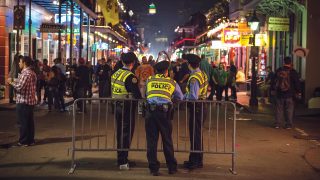
Over the past several years, gun violence has become a growing topic of concern nationwide. While there is no “one size fits all” solution to this problem, police departments can create their own custom plan for gun violence reduction in their municipalities. Reducing gun violence is everyone’s responsibility. It will require interventions through multiple systems, including public health, the criminal justice system and governing bodies. Increasing the availability of data and funding will help evaluate and create effective responses to reduce gun violence.
A threat assessment approach recognizes that individuals who threaten targeted violence are usually troubled, depressed and despondent over their circumstances in life.
Regulatory measures
The licensing of handgun purchasers, background check requirements for all gun sales and close oversight of retail gun sellers may reduce the diversion of guns to criminals. However, many new gun laws passed by our legislators are generally only obeyed by the lawful public, who are not the problem. These laws simply add more infringements.
Safe storage and gun safety
Most responsible gun owners already use gun safes and are well aware of safe handling practices for securing their weapons. A reasonable approach would focus on public service awareness campaigns or requiring prosecutors to actually prosecute existing gun laws when violated by career criminals. The safe storage approach is intended to prevent a weapon from being found by a curious child or stolen in a home or car burglary. Many guns involved in crimes are stolen. Accidental shootings often are the result of an unsecured firearm. Departments can provide safety tips and gun locks to the public to reduce the risk of leaving a firearm unsecured and readily available.
Extreme risk/red flag laws
Firearm prohibitions for high-risk groups, such as domestic violence offenders, persons convicted of violent crimes and individuals with mental illness who have been adjudicated as being a threat to themselves or others, have been shown to reduce violence. Local policymakers, police leaders, courts and social service providers should work together to implement extreme risk or red flag laws. Such legislation is a key step to preventing gun violence. Police departments need to help the public understand how to seek one of these protection orders. Individuals in crisis who are considering harming themselves or others often exhibit some warning signs. These laws can help police and others to proactively intervene and temporarily prevent a person in crisis from accessing firearms. Implementing these “surrender and enforcement” policies can prevent potential acts of gun violence by disarming individuals who should not possess guns.

Threat assessments
Basic threat assessments can identify warning factors, such as the presence of a gun in the home with increasing levels of substance or alcohol use and physical abuse. This information can be gleaned from police reports. An example of a proactive intervention can be a media campaign with public service announcements and billboards to educate and encourage the public to report people who illegally possess or use firearms in the commission of a crime. These programs can enlist local business leaders to provide rewards for anonymous tips that lead to arrests.
Many homicides have little to no predictive potential. However, when you consider domestic violence, stalking, school shootings and workplace violence–related killings, there is a drastic shift in predictability. The predictability of most events increases when you have the ability to closely examine the current and past behavior of human beings. These crimes often show escalating patterns toward increased lethality. Proactive violence intervention can identify and address individuals posing an increasing risk for gun violence. Given the link between domestic violence and firearms, these programs can be a critical factor in coordinating a comprehensive safety response.
In making predictions about the risk for mass shootings, there is no consistent psychological profile or set of warning signs that can be used reliably to identify such individuals in the general population. A more promising approach is the strategy of a behavioral threat assessment, which is concerned with identifying and intervening with individuals who have communicated threats of violence or engaged in behavior that clearly indicates planning or preparation to commit a violent act. A threat assessment approach recognizes that individuals who threaten targeted violence are usually troubled, depressed and despondent over their circumstances in life. A threat assessment leads to interventions intended to reduce the risk of violence by taking steps to address the problem that underlies the threatening behavior. Such problems can range from workplace conflicts to schoolyard bullying to serious mental illness to even potential homegrown terrorists. The FBI can assist local police departments with these assessments.
Former Albuquerque Police Commander Paul Szych is a nationally recognized threat mitigation consultant, speaker and police trainer on the topic of proactively avoiding domestic violence, stalking and workplace violence killing events. His latest book, Stop Him From Killing Them, provides a guide for police agencies to improve their identification and response to high-lethality threats to increase victim safety.
In determining best practices for law enforcement, we need to emphasize proactive prevention. Preventing violence requires a new ideology.
Technology
Technology can be of great assistance in addressing gun violence. However, it can be cost-prohibitive for the average small and midsize agencies across our nation. The ATF can help establish Crime Gun Intelligence Centers and create regional law enforcement partnerships to collect, analyze and manage evidence related to guns used in crimes. They can work with agencies to develop investigative leads by submitting guns to the ATF’s National Tracing Center for analysis. Bullet casings can also be analyzed through the National Ballistic Information Network (NIBIN) and entered into their database.
Data from a shot detection system can help identify hot spots and other high crime activity. Recovered casings can be traced to a particular gun and identify where and when it may have been fired in the past. This is very costly, and some large agencies like Chicago P.D. are eliminating this program. Integrated camera systems and license plate readers can be instrumental in providing leads in these cases. Again, these can be cost-prohibitive and may not be practical options for the average police department. Social media sites can also help identify offenders who often post pictures of themselves carrying firearms in violation of court orders or conditions of their probation or parole.
Other considerations
Some agencies have implemented violence intervention programs to seek out and directly communicate with at-risk individuals, groups or gangs through a partnership with law enforcement, local prosecutors, social service providers and community stakeholders. The partnership delivers a unified message against violent crime, explaining that any further acts will initiate attention and strict enforcement while articulating expectations for a safe community. Social services are offered as an alternative to violent crime. Schools can get engaged with gun violence prevention programs such as the Sandy Hook Promise to educate student, teachers and family members on these issues.
In determining best practices for law enforcement, we need to emphasize proactive prevention. Preventing violence requires a new ideology. By identifying warning signs and providing early intervention and other protective measures, we can work to improve public safety and reduce gun-related crime in our communities.
As seen in the April 2024 issue of American Police Beat magazine.
Don’t miss out on another issue today! Click below:





